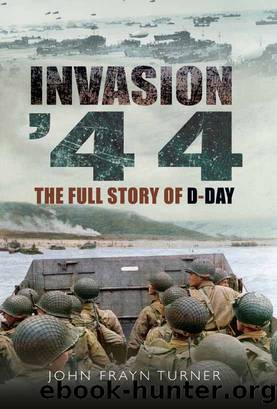Invasion '44 by John Frayn Turner

Author:John Frayn Turner [Turner, John Frayn]
Language: eng
Format: epub
ISBN: 9780552095419
Google: apVScAAACAAJ
Publisher: Corgi
Published: 1974-01-15T02:43:41+00:00
13
Death on Dog Green
IT was 0700 and the death on Dog Green was repeated as the second waves touched down in a series of landings lasting forty minutes. The remnants of A Company, 116th Regiment, were still staggering under the shock of those first twenty-five minutes as B Company bottomed. By this hour, too, the tide had flowed right into the obstacle beltâand through it by 0800 but the beach obstacles were not yet gapped in many places. No one had advanced beyond the shingle; tanks were unable to give much covering fire; and the tide would have risen eight feet in the next hour. Not a bright prospect.
By luck, only a small part of the three companies actually landed on Dog Green, where the same shattering, clattering crossfire reduced their strength in minutes of massacre. Everything was happening in minutesâseconds, even; yet seconds could seem eternities. A machine-gun burst stabbed the line of the tide, and its bullets broke the surface, throwing up spurts of spray before reaching and riddling a wounded G.I. as he hung on to an underwater obstacle. His grip gave way.
The same destructive fire pinned B Company to the waterâs edge.
Some of the craft were saved by the tide as the wind whipped them a little to the left. Behind the cover of a providential pall of smoke the men got across the open beach to the blind side of a sea-wall, and overcame all obstacles, wire, and mines to penetrate inland.
Following ten minutes behind B Company, C came in at 0710 at the west end of Dog White. One of its six craft got off to a bad, if not fatal, start by running right into a mined obstacle. For twenty frantic minutes they manoeuvred in the surf to get free without detonating the mines! Only one other craft suffered a setback: the sea threw it against a ramp, and it capsized, spilling the men into five feet of water, and losing all its precious flame-throwers and charges.
Still almost as many died in the water as ashore. Three of D Companyâs six craft shipped water seriously, and one had to be abandoned before the invasion began.
Four hundred yards out another one suddenly sank in a stream of surf, and the men were flung into the water, where they struggled to swim for shore. Desperate over-arm strokes threshed the waves, as the men swam under a blinding barrage of mortars and bullets. About half of them reached the damp sands.
A section of D Company disembarked a long way out, and saw riflemen lying full-length in the shallows, sheltering behind the steel obstacles. Those who eventually got ashore had, for their total arms, one mortarâwithout ammunition.
So it went on. Death and glory. Battalion headquarters and Headquarters Company of one battalion came in on time, but when the ramps went down the fire was so intense that many men took refuge behind some tanks, only to find these the targets of large-scale artillery fire.
Later Major Sidney Bingham,
Download
This site does not store any files on its server. We only index and link to content provided by other sites. Please contact the content providers to delete copyright contents if any and email us, we'll remove relevant links or contents immediately.
The Radium Girls by Kate Moore(11971)
100 Deadly Skills by Clint Emerson(4879)
Rise and Kill First by Ronen Bergman(4739)
The Templars by Dan Jones(4656)
The Doomsday Machine by Daniel Ellsberg(4449)
The Rape of Nanking by Iris Chang(4166)
Killing England by Bill O'Reilly(3969)
Hitler in Los Angeles by Steven J. Ross(3923)
Stalin by Stephen Kotkin(3918)
12 Strong by Doug Stanton(3527)
Hitler's Monsters by Eric Kurlander(3291)
Blood and Sand by Alex Von Tunzelmann(3164)
The Code Book by Simon Singh(3138)
Darkest Hour by Anthony McCarten(3096)
The Art of War Visualized by Jessica Hagy(2973)
Hitler's Flying Saucers: A Guide to German Flying Discs of the Second World War by Stevens Henry(2731)
Babylon's Ark by Lawrence Anthony(2649)
The Second World Wars by Victor Davis Hanson(2502)
Tobruk by Peter Fitzsimons(2479)
